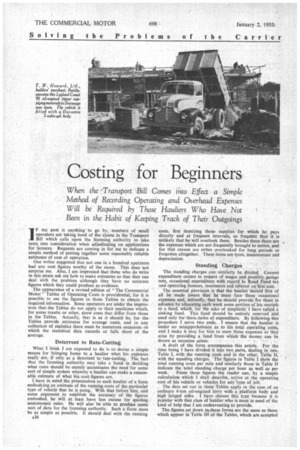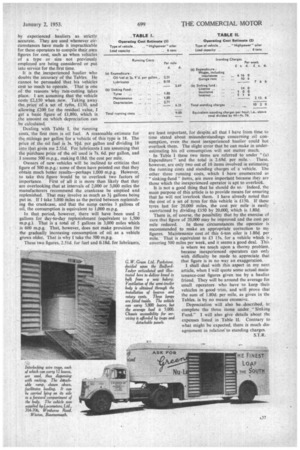Costing for Beginners
Page 54

Page 55

If you've noticed an error in this article please click here to report it so we can fix it.
When the -Transport Bill Comes into Effect a Simple Method of Recording Operating and Overhead Expenses Will be Required by Those Hauliers Who Have Not Been in the Habit of Keeping Track of Their Outgoings
IF my post is anything to go by, numbers of small operators are taking heed of the clause in the Transport Bill which calls upon the licensing authority to take rates into consideration when adjudicating on applications for licences. Requests are coming in for me to indicate a simple method of putting together some reasonably reliable estimates of cost of operation.
One writer suggested that not one in a hundred operators had any cost figures worthy of the name. This does not surprise me. Also, I am impressed that those who do write in this strain ask me hoW to make estimates so that they can deal with the problem although they have no accurate figures which they could produce as evidence.
The appearance of a revised edition of "The Commercial Motor" Tables of Operating Costs is providential, for it is possible to use the figures in those Tables to obtain the required information. Some operators are under the impression that the Tables do not apply to their machines which, for some reason or other, show costs that differ from those in the Tables. Actually, that is as it should be, for the Tables provide estimates for average costs, and in any collection of statistics there must be numerous occasions on which the statistical data exceeds or falls short of the average.
Deterrent to Rate-Cutting
What I think I am expected to do is to devise a simple means for bringing home to a haulier what his expenses really are, if only as a deterrent to rate-cutting. The fact that the licensing authority may take a hand in deciding what rates should be merely accentuates the need for some sort of simple system whereby a .haulier can make a reason able estimate of what his cost figures are. • I have in mind the presentation to each haulier of a form embodyingan estimate of the running costs of the particular type of vehicle that he is using. With that before him, and some argument to establish the accuracy of the figures embodied, he will at least have less excuse for quoting uneconomic rates. He will also be able to produce some sort of data for the licensing authority. Such a form must be as simple as possible. It should deal with the running A36 costs, first itemizing those supplies for which he pays directly and at frequent intervals, so frequent that it is unlikely that he will overlook them. Besides these there are the expenses which are not frequently brought to notice, and for that reason are either overlooked for long periods or forgotten altogether. These items are tyres, maintenance and depreciation.
Standing Charges
The standing charges can similarly be divided. Current expenditure occurs in respect of *ages and Possibly garage rent, occasional expenditure with regard to Road Fund tax and operating licences, insurances and interest on first cost.
The essential provision is that the haulier should first of all be made aware that he must face these occasional expenses and, secondly, that he should provide for them in advance by allocating each week some portion of his receipts to a fund, which, for the sake of simplicity I have called a sinking fund. This fund should be entirely reserved and used only for these .items of expenditure. By following this procedure I serve two ends. I ensure that the haulier is under no misapprehension as to his total operating costs, and I make it easy for him to meet those expenses as they arise by providing a fund from which the money can be drawn as occasion arises. •
A draft of the form accompanies this article, For the time being I have divided it into two parts, dealing in one, Table I, with the running costs and in the other, Table 11, . with the standing charges. The figures in Table I show the total running costs per mile and similarly those in Table II indicate the total standing charge per hour as well as per
week. From these figures the reader can, by a simple calculation which I shall describe, arrive at the operating cost of his vehicle or vehicles for any 'type of job.
The data set out in these Tables apply in the case of an ordinary 6-ton oil-engined lorry with a platform body and high hinged sides. I have chosen this type because it is popular with that class of ha-Wier who is most in need of the kind of help that I am endeavouring to provide.
The figures set down inrthese forms are the same as those which appear in Table III of the Tables, which are accepted by experienced hauliers as strictly accurate. They are used whenever circumstances have made it impracticable for these operators to compile their on figures for cost, such as when vehicles of a type or size not previously employed are being considered or put into service for the first time.
It is the inexperienced haulier who doubts the accuracy of the Tables. He cannot be persuaded that his vehicles cost so much to operate. That is one of the reasons why rate-cutting takes place. I am assuming that the vehicle costs £2,150 when new. Taking away the price' of a set of tyres, £150, and allowing £200 for the residual value, I get a basic figure of £1,800, which is the amount on which depreciation can be calculated.
Dealing with Table I, the running costs, the first item is oil fuel. A reasonable•estimate for the mileage per gallon for a vehicle of this type is 18. The price of the oil fuel is 3s. 91d. per gallon and dividing 18 into that gives me 2.51d. For lubricants I am assuming that the purchase price of the oil used is 7s. 6d. per gallon, and I assume 500 m.p.g., making 0.18d. the cost per mile.
Owners of new vehicles will be inclined to criticize that figure of 500 m.p.g.: some of them have pointed out that they obtain much better results—perhaps 1,000 m.p.g. However, to take this figure ' Would be to overlook two factors of
importance. First of all it is more than likely that they are overlooking that at intervals of 2,000 or 3,000 miles the manufacturers recommend the crankcase be emptied and replenished. That may involve as much as 34 gallons being put in. If I take 3,000 miles as the period between replenishing the crankcase, and that the sump carries 3 gallons of oil, the consumption is equivalent to 1,000 m.p.g.
In that period; however, there will have been used 2 gallons for day-to-day replenishment (equivalent to 1.500 m.p.g.). That is a total of 5 gallons in 3,000 miles which is 600 m.p.g. That, however, does not make prov,ision for the gradually increasing consumption of oil as a vehicle grows older. That is why I take the 500 m.p.g.
These two figures, 2.5Id. for fuel and 0.18d. for lubricants, are least important, for despite all that I have from time to time stated about misunderstandings concerning oil consumption, even the most inexperienced haulier could not overlook them. The slight error that he can make in underestimating his oil consumption will not matter much.
In Table 1 these two items are referred to under "(a) Expenditure" and the total is 2.69d per mile. These, however, are only two out of 10 items involved in estimating the running Costs and standing charges of a vehicle. The other three running costs, which I have enumerated as " sinking-fund " items, are more important because they are those which the inexperienced operator is apt to overtook.
It is not a good thing that he should do so. Indeed, the main purpose of this article is to provide means for ensuring that he will not -overlook them. I have already noted that the cost of a set of tyres for this vehicle is £150. If these tyres last for 20,000 miles, the cost per mile is easily ascertained by dividing £150 by 20,000, which is 1.80d.
There is, of course, the possibility that by the exercise of care that figure of 20,000 may be improved and the cost per mile reduced. In those circumstances the operator is recommended to make an appropriate correction to my figures. Maintenance cost of this 6-ton oiler is I.80d. per mile. That is equivalent to £3 15s. for a vehicle which is , covering 500 miles per week, and it seems a good deal. This is where we touch upon a thorny problem. because inexperienced operators can only with difficulty be made to appreciate that • that figure is in no way an exaggeration. I shall deal with this aspect in my next article, when I will quote some actual maintenance-cost figures given me by a haulier friend. They will be around the average for small operators who have to keep their vehicles in good trim, and will prove that the sum of I.80d. per mile, as given in the Tables, is by no means excessive.
Depreciation will also be—described, tc. complete the three items under _ " Sinking Fund." I will also give details about the expenses listed in Table 11. Contrary to what might be expected, there is much disagreement in relation' to standing charges.
S.T.R.




















































































